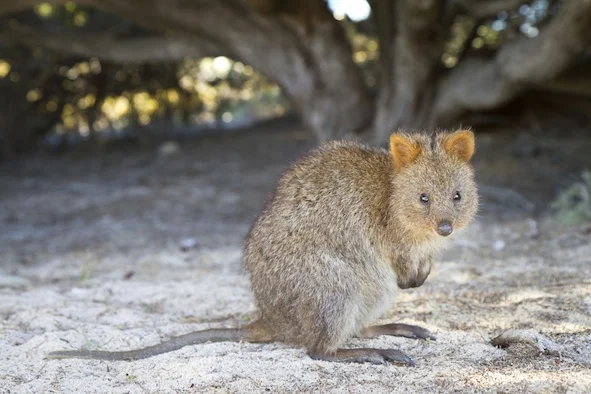A quokka is a kind of wallaby.
They are small with thick grey fur.
They eat leaves and grass.
They sleep in the day and move about at night.
The female has a pouch for its babies to grow in.
©Getty Images
What is a quokka?
A quokka is a small marsupial. The quokka is a kind of wallaby, but some scientists have found that it is really in a group of its own.
Unlike other wallabies, it has a short stiff tail and short hind feet. Its ears are more rounded than those of other wallabies, and its skull and teeth are different. The name 'quokka' comes from the name given to it by the Aboriginal people of that part of the southwest of Australia.
Habitat and Distribution (where they are found)
Quokkas are plentiful on Rottnest Island off the coast of Western Australia near Perth. They used to be common in the south west parts of Western Australia, but there are now only small groups found there.
They live in long grasses and shrubs, where they make pathways that they move along to find food or to escape if disturbed.
©Getty Images
Appearance and Behaviours
The quokka is about 80 centimetres long, about the size of a domestic cat. It weighs about 4 kilograms. It has longish coarse grey fur. Quokkas hop like wallabies. Quokkas live in family groups led by a male. They are nocturnal, which means active at night, and gather in large social groups, often at water holes. At sunrise family groups return to a shelter in thick vegetation to spend the day. The group will sometimes change shelter, but basically the quokka is a creature of habit and returns to the same place each day.
Diet
Quokkas eat grasses and the leaves of shrubs and small trees. At the western part of Rottnest Island there is no water in summer, so the quokkas in that area eat the leaves of succulent plants in order to get enough moisture.
Life Cycle
A young quokka peeping out of its mother’s pouch. ©Getty
When the young are older, they come out of the pouch every now and then. ©Getty Images
Like other marsupials, the female gives birth to a tiny baby, called a joey. When it is born, the joey is very small and undeveloped, and it moves into her pouch within minutes after birth.
The joey stays in the pouch full time for about 5 months, attached to a teat that feeds it milk.
The joey then spends the next 2 months coming and going, staying out of the pouch for longer and longer periods of time. During this time it drinks less milk too, but when it does, it is always from the same teat. This is because the milk from that teat changes as the joey grows so that it always gets the right nutrition it needs.
Conservation status and Threats
Quokkas are listed as Vulnerable. They were once found all over southwestern Australia, but are now rarely seen on the mainland. They are plentiful only on Rottnest Island, Western Australia.
Clearing of its habitat for houses and logging is a major threat.
©Getty Images






